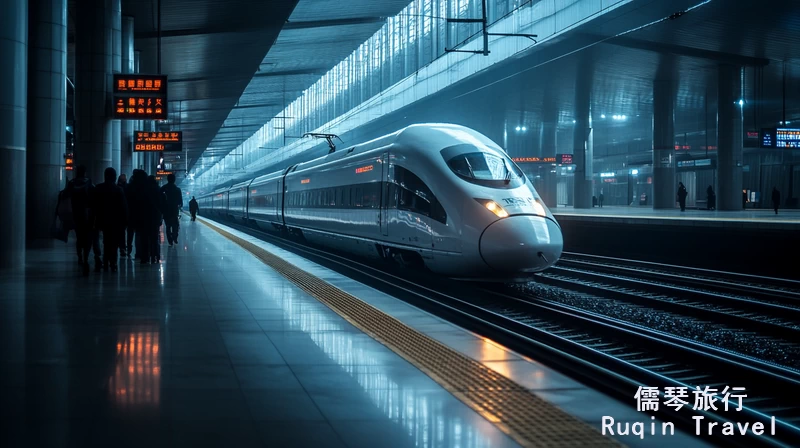China’s train system is one of the most extensive and efficient in the world. It offers a reliable and scenic way to explore the country’s vast landscapes. Whether you’re interested in the modern high-speed trains or the classic overnight routes, train travel in China provides a unique and comfortable experience.
This guide will provide essential information on how to navigate the Chinese train system, buy tickets, choose the right class, and much more.
1. Overview of Train Travel in China
China’s railway network spans over 141,000 kilometers, making it one of the largest in the world. It connects major cities, towns, and even remote areas. China train travel offers a range of options, from ultra-modern high-speed trains to traditional sleeper trains. Train travel in China is not only efficient but also an affordable way to see the country.
High-speed trains (also known as bullet trains) are among the fastest in the world, reaching speeds of up to 350 km/h. These trains connect major cities like Beijing, Shanghai, and Guangzhou, making them ideal for business travelers and tourists alike. On the other hand, the traditional trains offer a more relaxed pace, allowing you to enjoy the scenic countryside.
2. Understanding the Chinese Train System
The Chinese train system is well-organized, with clear schedules and frequent services. There are several types of trains, categorized by their speed and service level. High-speed trains (G, D, C trains) are the fastest and most modern. They offer a smooth and comfortable ride, making them a popular choice for long-distance travel.
Next, Z, T, and K trains are conventional trains, usually slower and often used for overnight journeys. They are a good option if you’re traveling on a budget or want to experience a more traditional way of travel. Additionally, Y trains are tourist trains that operate on special routes, offering scenic journeys.
Each train has different classes, including business, first, and second class on high-speed trains and soft sleeper, hard sleeper, and hard seat on conventional trains. Understanding these classes can help you choose the best option for your comfort and budget.
3. Buying Train Tickets in China
Purchasing China train tickets can be done in several ways. First, you can buy tickets online through official websites or third-party platforms. This method allows you to book in advance and choose your preferred seats. Next, tickets can also be purchased at train stations, where you can pay in cash or with a Chinese bank card. China Train Ticket Booking online.
Additionally, many hotels and travel agencies offer ticket booking services. They can be convenient, especially if you don’t speak Chinese. However, they may charge a small service fee. Further, it’s important to book tickets as early as possible, especially during peak travel seasons like Chinese New Year or Golden Week.
Lastly, always carry your passport when purchasing tickets or boarding a train. It’s required for identification and verification. Knowing these details can ensure a smooth and hassle-free experience when buying train tickets in China.
4. How to Navigate Chinese Train Stations
Navigating Chinese train stations can be overwhelming due to their size and the language barrier. However, with a bit of preparation, it becomes manageable. Firstly, arrive at the station at least an hour before your departure. Chinese train stations are large, and it can take time to find your way.
Next, look for the departure board, which displays train numbers, destinations, and departure times. These boards are usually in Chinese and English. Additionally, follow the signs to the waiting area corresponding to your train. You’ll need to show your ticket and passport to enter this area.
Further, listen for announcements about your train. These are usually in Chinese, but major stations may also have English announcements. Lastly, when it’s time to board, follow the signs to the platform. Train attendants will check your ticket again before you board.
5. What to Expect on Chinese Trains
Traveling on Chinese trains is generally a comfortable experience. On high-speed trains, expect clean and modern interiors with spacious seats. Business and first-class seats offer more legroom and extra amenities, such as meals and refreshments. Second-class seats are more affordable and still provide a comfortable journey.
On overnight trains, you’ll find different classes of sleeper berths. Soft sleepers offer private compartments with four berths, while hard sleepers are open compartments with six berths. Hard seats are the most economical but less comfortable for long journeys.
Next, many trains have a dining car offering a selection of Chinese meals and snacks. However, the food can be pricey and not always to everyone’s taste. Additionally, vendors often sell snacks and drinks along the aisles. It’s a good idea to bring your own food and drinks, especially for longer journeys.
Further, toilets on trains can vary in cleanliness. High-speed trains usually have both Western-style and squat toilets. Lastly, power outlets and Wi-Fi are available on many trains, making it easy to stay connected.
6. Best Train Journeys in China
China offers some spectacular train journeys that provide stunning views of the country’s diverse landscapes. Firstly, the journey from Beijing to Shanghai on the high-speed train is popular, taking around 4.5 hours. It offers a glimpse into both cities’ modern and historical aspects.
Next, the Chengdu to Lhasa route offers a breathtaking journey across the Tibetan Plateau. Known as the “Roof of the World,” this route provides stunning views of snow-capped mountains and vast plains. Additionally, the Kunming to Dali route in Yunnan province showcases beautiful lakes and mountains.
Further, the Guilin to Guangzhou route offers views of picturesque karst landscapes and rivers. Lastly, the Harbin to Dalian route offers a scenic coastal journey, especially beautiful in winter when the landscape is covered in snow.
7. China Train Classes and Ticket Types
Understanding China train classes and ticket types is essential for a comfortable journey. High-speed trains offer three main classes: business, first, and second class. Business class offers the most luxurious experience with spacious seats, while first-class provides more comfort than second-class.
Next, on conventional trains, you’ll find soft sleeper, hard sleeper, and hard seat classes. Soft sleepers offer more privacy and comfort, while hard sleepers are more economical but still provide a good level of comfort. Hard seats are the cheapest but are best for short journeys.
Additionally, some trains offer standing tickets when seats are sold out. These are the least expensive but can be uncomfortable for long journeys. Lastly, children’s tickets are available at a discounted rate, usually half the price of an adult ticket, depending on the child’s height.
8. China Train Travel Tips for Foreigners
Traveling by train in China can be an enjoyable experience if you’re well-prepared. First, always carry your passport and a printed copy of your ticket. Next, pack essentials like snacks, water, and a power bank. Additionally, bring a small travel pillow and blanket for overnight journeys.
Further, learn a few basic Chinese phrases, especially if you’re traveling to less touristy areas. This can help with communication in case of any issues. Moreover, download a translation app and offline maps to navigate and understand signs.
Lastly, respect local customs and be considerate of other passengers. For example, keep noise levels low and follow the train’s rules and regulations. These tips can make your train travel experience in China smooth and pleasant.
9. Safety and Etiquette on Chinese Trains
China train travel safety is generally high, but it’s always wise to take precautions. Firstly, keep your belongings secure and within sight, especially in crowded stations. Next, avoid leaving valuables unattended and be cautious of pickpockets.
Additionally, follow train etiquette. For instance, avoid speaking loudly and respect the personal space of other passengers. Further, always wait in line when boarding and disembarking. This shows respect and helps maintain order.
Moreover, be mindful of local customs, such as not putting your feet on seats and disposing of trash properly. Lastly, if you experience any issues, approach train staff for assistance. They are usually helpful and can address any concerns you may have.
10. How to Travel by Train in China: A Step-by-Step Guide
Traveling by train in China involves a few straightforward steps. First, purchase your ticket either online, at the station, or through a travel agent. Next, arrive at the station early to allow time for security checks and finding your waiting area.
Additionally, check the departure board for your train information and follow the signs to the correct waiting area. Further, when your train is ready for boarding, present your ticket and passport to the attendant. Lastly, find your seat or berth, store your luggage, and enjoy the journey.
During the trip, keep your ticket handy, as it may be checked again. Upon arrival, gather your belongings and follow the signs to the exit. Following these steps can ensure a smooth and enjoyable train travel experience in China.
China’s train system offers an efficient and scenic way to explore the country. From high-speed trains connecting major cities to overnight journeys through stunning landscapes, train travel in China provides a unique and comfortable experience.
This guide has covered everything you need to know, from buying tickets and navigating train stations to understanding train classes and travel tips. By following these tips and being well-prepared, you can enjoy a seamless and memorable train journey across China. Whether you’re a first-time visitor or a seasoned traveler, the Chinese train system is an excellent way to discover the beauty and diversity of this vast country. Safe travels! Check out China Survival Guide for more information.




Hi. I understand that there are restrictions on the size and weight of luggage for high speed trains. Are this strictly enforced particularly on weight?